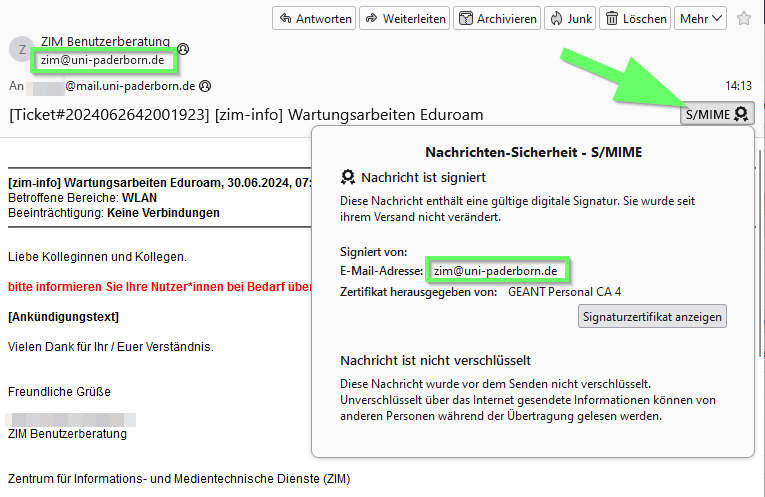| Zeile 12: | Zeile 12: | ||
E-mail certifications are an additional protection instance to verify the sender address and the content of the message. | E-mail certifications are an additional protection instance to verify the sender address and the content of the message. | ||
This especially helps to unmask phishing e-mails posing as popular services (e.g., online banking, parcel services, e-mail providers, etc.). | This especially helps to unmask phishing e-mails posing as popular services (e.g., online banking, parcel services, e-mail providers, etc.). | ||
| − | Phishing attempts are an increasingly frequent attack on user data and are sometimes more, sometimes less easily distinguishable from "real" e-mails. They are not based on malware, but on deceiving the recipient into believing that he or she has received a genuine request. More information about phishing including detailed examples can be found here: [https://hilfe.uni-paderborn.de/Hinweise_zu_Phishing-E-Mails Notes on phishing emails] | + | Phishing attempts are an increasingly frequent attack on user data and are sometimes more, sometimes less easily distinguishable from "real" e-mails. They are not based on malware, but on deceiving the recipient into believing that he or she has received a genuine request. More information about phishing including detailed examples can be found here: [https://hilfe.uni-paderborn.de/Hinweise_zu_Phishing-E-Mails/en Notes on phishing emails] |
If you receive a '''certified e-mail''', you can rely both on the sender address displayed and on the fact that the content of the e-mail was not manipulated during transmission. | If you receive a '''certified e-mail''', you can rely both on the sender address displayed and on the fact that the content of the e-mail was not manipulated during transmission. | ||
| Zeile 39: | Zeile 39: | ||
In popular desktop apps, as well as Webmail, certified emails are displayed as follows. | In popular desktop apps, as well as Webmail, certified emails are displayed as follows. | ||
| − | = | + | |
| − | Outlook | + | <bootstrap_accordion> |
| − | = | + | <bootstrap_panel id="Outlook" >[[Datei:E-Mail signieren Outlook.png|600px|mini|ohne|'''Outlook''']]</bootstrap_panel> |
| − | Thunderbird | + | <bootstrap_panel id ="Thunderbird">[[Datei:E-Mail signieren Thunderbird.png|600px|mini|ohne|'''Thunderbird''']]</bootstrap_panel> |
| − | = | + | <bootstrap_panel id ="Apple-Mail">[[Datei:E-Mail signieren Apple-Mail.png|600px|mini|ohne|'''Apple-Mail''']]</bootstrap_panel> |
| − | Apple | + | <bootstrap_panel id ="Webmail">[[Datei:E-Mail signieren Webmail.png|592px|mini|ohne|'''Appearance in Webmail''']]</bootstrap_panel> |
| − | = | + | <bootstrap_panel id ="OWA">[[Datei:E-Mail signieren OWA.png|700px|mini|ohne|'''Appearance in OWA (via Internet Explorer)''']]</bootstrap_panel> |
| − | + | </bootstrap_accordion> | |
| − | Appearance in | ||
| − | = | ||
| − | |||
== S/MIME certification and encryption == | == S/MIME certification and encryption == | ||
Version vom 24. Oktober 2023, 10:14 Uhr
This tutorial provides information about the benefits and recognition of certified emails certified via the S/MIME procedure.
There is also the option to certify emails via the PGP procedure. For this method, users have to install additional plugin(s) and the public key of the respective sender has to be downloaded separately. In addition, the cryptographic key is not issued by a certification authority, but is generated privately.
Certified e-mails (S/MIME)[Bearbeiten | Quelltext bearbeiten]
What is a certified e-mail[Bearbeiten | Quelltext bearbeiten]
E-mail certifications are an additional protection instance to verify the sender address and the content of the message. This especially helps to unmask phishing e-mails posing as popular services (e.g., online banking, parcel services, e-mail providers, etc.). Phishing attempts are an increasingly frequent attack on user data and are sometimes more, sometimes less easily distinguishable from "real" e-mails. They are not based on malware, but on deceiving the recipient into believing that he or she has received a genuine request. More information about phishing including detailed examples can be found here: Notes on phishing emails
If you receive a certified e-mail, you can rely both on the sender address displayed and on the fact that the content of the e-mail was not manipulated during transmission.
Therefore, pay attention to the sender address! It should not say benutzerberatung@upb.de.hackerparadies.com or anything similar.
The IMT sends e-mails under imt@uni-paderborn.de or imt@upb.de.
Who can certify their own e-mails (S/MIME)[Bearbeiten | Quelltext bearbeiten]
Anyone who has had their identity certified by the certification authority responsible for their e-mail address can certify e-mails. During this process, the e-mail address whose e-mails are to be certified in the future must be specified. The IMT (Center for Information and Media Technologies), for example, has the possibility to issue certificates for members of the University of Paderborn.
This includes all e-mail addresses of the following formats:
- *@uni-paderborn.de
- *@mail.uni-paderborn.de
- *@campus.uni-paderborn.de
- *@*.uni-paderborn.de
- *@*.upb.de
More information about application: Applying for an e-mail SSL certificate
How to recognize certified e-mails?[Bearbeiten | Quelltext bearbeiten]
E-mail programs display correctly certified e-mails differently. Usually, a confirmation icon appears in the header of the message, as well as a reference to the sender.
Mobile devices (smartphones, tablets) are unfortunately an exception to the rule. The manufacturer, app used and version of the OS (Android/iOS) determine whether a notice appears or not. In our experience, most mail apps are currently unable to display the certification correctly. There are efforts by the operators to change this.
In popular desktop apps, as well as Webmail, certified emails are displayed as follows.
S/MIME certification and encryption[Bearbeiten | Quelltext bearbeiten]
Every certified e-mail also contains the sender's public cryptographic key. Common e-mail programs store this key with the corresponding contact in the address book. If you have the ability to certify your own e-mails, you can encrypt e-mails to the contact in question from this point on.
- Certified e-mail = public key from sender
- Public key + own S/MIME certificate = option to encrypt (to the contact)
Further information[Bearbeiten | Quelltext bearbeiten]
- Information security - overview of all articles
- Email: Applying for a SSL certificate









